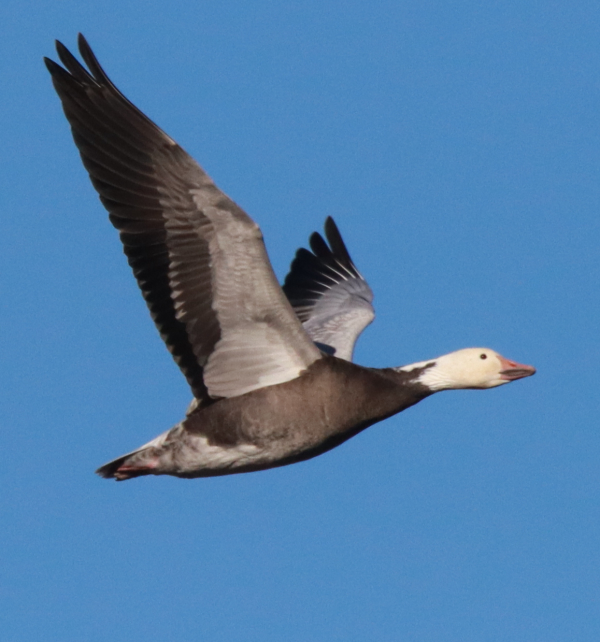
A beautiful flight portrait of an adult blue morph Snow Goose, one of thousands that make up huge flocks during this migration stopover period with white morph Snows and Ross’s Geese.
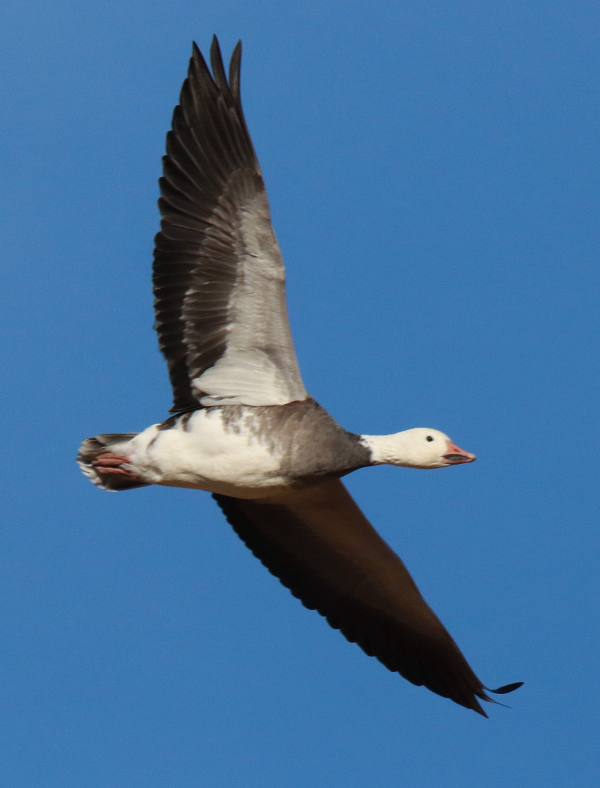
Similar to the above blue morph, the white belly plumage indicates this is an adult hybrid Snow Goose, the product of a blue morph adult breeding with a white morph Snow Goose.
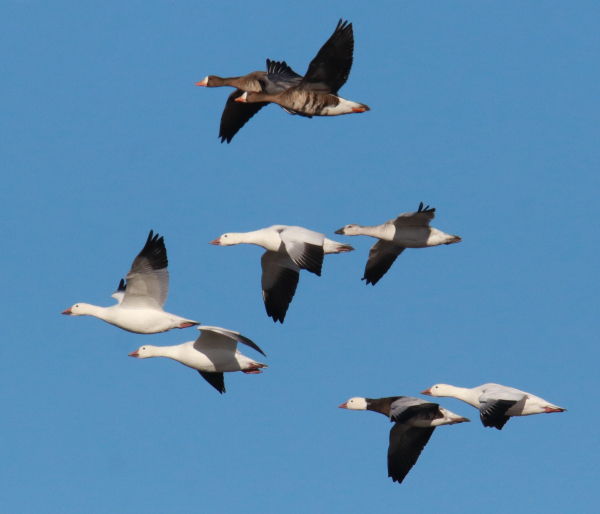
A pair of White-fronted Geese joined a group of Snow Geese that includes a blue morph adult, 4 adult white morph Snows, and a juvenile white morph. To learn more about the different plumages of Snow Geese and Ross’s Geese, see the Bird Photography feature in this issue.
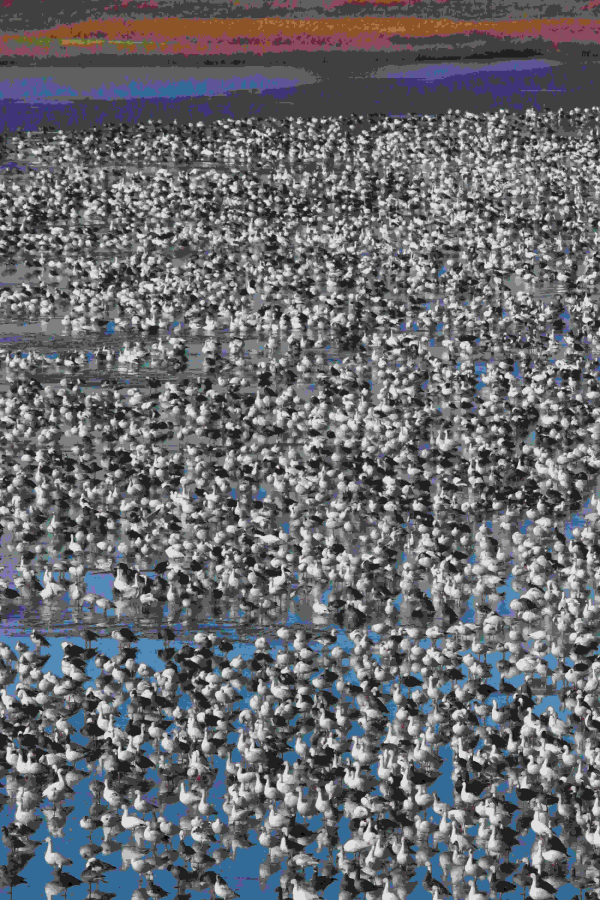
About 1/6th of the huge flock that concentrated at my friend Herb’s lake, these Snow Geese and Ross’s Geese were 1 of 12 huge flocks found within 15 miles of The Birding Wire office in southeast North Dakota.
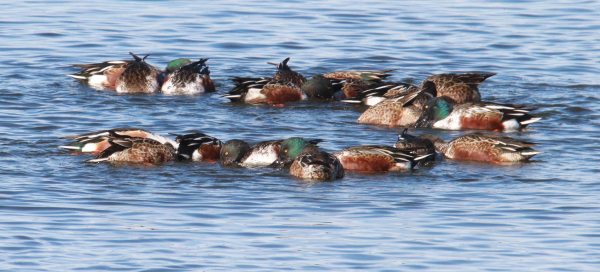
An area lake attracted about 60 Northern Shovelers that were filter feeding in such a way that they created a few circles of ducks as they were cooperatively feeding on aquatic invertebrates.
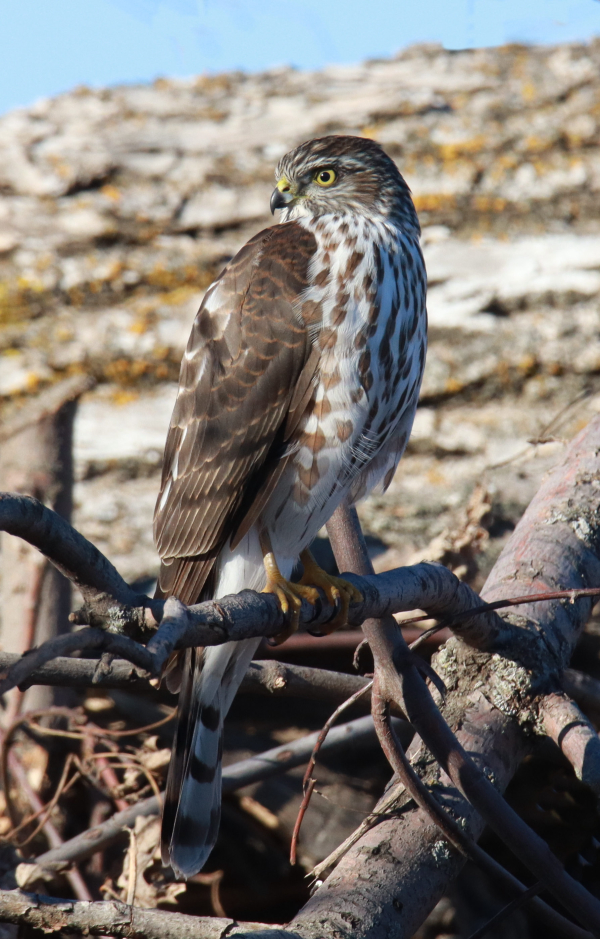
A small juvenile male Cooper’s Hawk was a surprise sighting Saturday morning.

A Rough-legged Hawk circled above a field while searching for small rodents below.
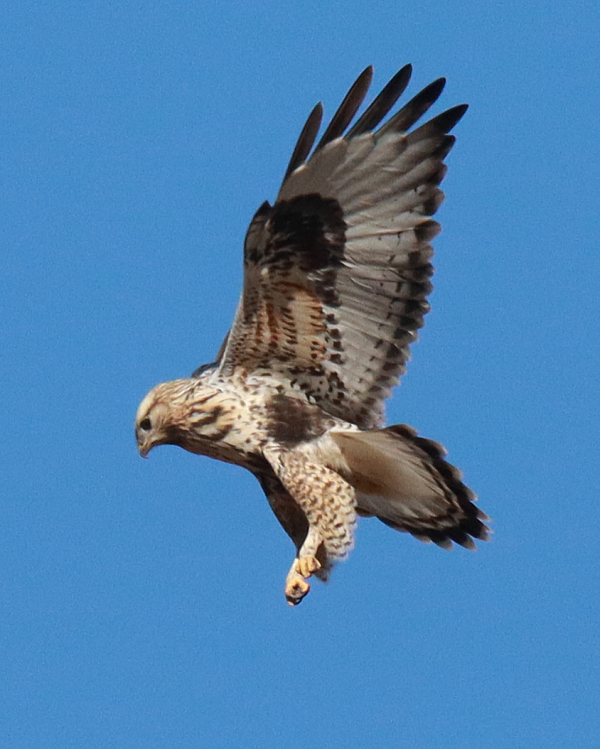
When the Rough-legged Hawk began hovering, it provided a different photo view of the action, from the side rather than the usual head-on angle. Note that its legs are hanging downward, which helps to stabilize the hawk as it hovers.
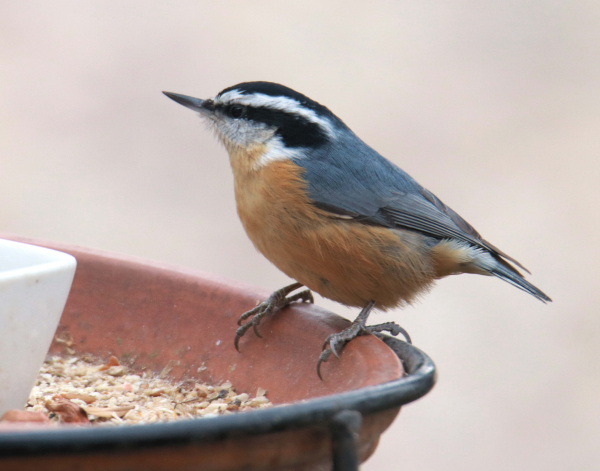
A new boldly colored Red-breasted Nuthatch arrived at the feeding station Monday, as did a new female Downy Woodpecker and at least one new American Goldfinch.
|
Thursday morning provided a Big Reveal as I began to survey a larger portion of the local area for birds, especially large flocks of waterfowl. My first stop was only a mile south of home where a huge flock of Snow Geese was feeding, and I arrived just in time to witness small flocks beginning to break away to relocate to a second harvested cornfield. Flock after flock, and multiple flocks at a time provided a classic goose migration feeding flight complete with beautiful morning sunlight and clear, fresh weather punctuated by the sounds of hundreds of Snow Geese and Ross’s Geese, although there were thousands in the feeding flock. That morning I found 12 more flocks like this or larger within 15 miles to the west, southwest, south, and north of which 3 huge flocks were within a mile of home!
There were also smaller flocks of hundreds of geese rather than thousands or tens of thousands. I gave up on trying to estimate the numbers of geese in these mega-flocks, so now I am calling flocks numbering more than 1,000 “huge flocks,” and flocks in the hundreds “large flocks.” There were 2 large flocks of Snows and Ross’s Geese, and 1 large flock of Canadas and White-fronted Geese; plus there were a few smaller flocks of Canada and Cackling Geese numbering about 40, 70, and 25.
After checking out the huge flocks of Snow Geese a mile south and a mile north, I drove west to see huge flocks of Snows at mile 2, 3, 4, and 7, which was a bit overwhelming to witness such an abundance of birds of any kind – how exciting! Swans were the next most common waterfowl, with the largest concentration including more than 100, and other groups numbering 25, 2, 8, 7, and 5. Mallards were the next most common birds, and there was a concentration of about 60 Northern Shovelers that were filter feeding in such a way that they created circles of ducks on the surface where they were feeding on aquatic invertebrates, which I’ve witnessed before.
Raptors sighted included a pair of adult Bald Eagles and a separate second-year immature. There were also 3 Rough-legged Hawks, including 2 in “Hawk Valley,” which I hope is an exciting late fall indication of more Arctic-nesting raptors to arrive there, and I had a chance to photograph another Rough-leg just 2 miles south of there. I also observed the first flock of Snow Buntings, numbering about 35, and the only other birds included a cock pheasant and a very late White Pelican standing on a muskrat lodge surrounded by ice.
Minnesota Afternoon
Even after making a big drive into central Minnesota the previous Sunday, I headed east to the Detroit Lakes area Wednesday to take another walk in the woods. Actually, it was my Sunday walk with my young nephew Blake that prompted my drive to another native woodland where I spent a couple hours hiking through a similar woodland that covered a series of hills. The most exciting thing about that day trip was that just 10 steps into my walk a loud piercing call broke the silence of the woods – another Pileated Woodpecker! I was standing on a hilltop, looking out upon a clear blue sky above the tree tops, hoping to see the big woodpecker. The call of the wild sounded again.
The calls emanated from a position that seemed to be close to the ground, and a half-minute later I saw the woodpecker’s flight through the lower level of the trees, and appreciated a nice but distant look as the big woodpecker winged ever-higher and ever farther north toward the next wooded area. WoW! What a beginning; but it was the only bird I saw during my hike, although I did hear a couple Blue Jays in the area. In the interior of the woodland, I didn’t see any woodpecker cavities in the trees, but there was plenty of evidence of Pileated Woodpeckers digging into rotted tree trunks and branches that were lying on or near the forest floor – searching for carpenter ants no doubt.
Finishing my fulfilling hike an hour before sunset, I drove my Lakes Birding Route and sighted a small flock of Trumpeter Swans with 3 adults and 2 young. I was also glad to see a late Common Loon from the north shore of Pelican Lake and another preening as it floated on the calm water of Little Pelican Lake. I’m not sure if I satiated my interest in walking through the Northwoods this fall, but time will tell. The warm afternoon temperature and light breeze were important elements to enjoying a part of Minnesota’s western-most woodlands that memorable November afternoon.
Farther West
Friday morning I wanted to see if the avian action had changed to the west and northwest of home, but for the most part, concentrations of geese and Tundra Swans remained pretty static since the previous week’s check of Napoleon Lake, Wentz Lake, Cindy’s Lake, and points between. However, a huge flock of Snow Geese and a large flock of White-fronted Geese were present at Napoleon Lake, an hour away. With that information in mind, and considering the few small flocks of geese that I saw along my 3-hour drive east to the Detroit Lakes area 2 days earlier, it provided an overall message that The Birding Wire office was located in the midst of the central stopover location for Snow Geese in southeast North Dakota. Certainly, the sounds of Snow Geese permeated the air day and night, with flocks of geese flying overhead regularly to signal a peak period of late fall migration.
During my extended drive west and northwest, a few raptors were present but they were widely scattered. The standouts were 2 lone Rough-legged Hawks that I observed hunting, which included their characteristic hovering actions, sometimes culminated by a dive from far above to try to seize a small ground-based rodent. There were also 2 adult Bald Eagles, widely separated by miles, but 1 was perched next to a Bald Eagle nest, similar to what I observed the last time I ventured into South Dakota – intriguing behavior for November. There were also 4 Northern Harriers on the wing, the most common raptors in the region during recent weeks.
Saturday provided more action among the huge feeding flocks of Snow and Ross’s Goose locally, with small flocks of Cackling and White-fronted Geese segregated from the other geese but obvious too. Of course, some goose flocks change the fields they feed in, as well as which lake or field the choose to rest at. Flocks co-mingle and separate, seemingly on a whim, and you never know if flocks are leaving the area or if a new flock is filling in from the north. Saturday morning was special because one of the big mixed flocks if geese began to use Melody’s Marsh as its center of activity, even feeding in a harvested cornfield just behind Melody’s Grove and the iconic barn on the edge of the abandoned farmyard, just few hundred yards from my home. Later that day I took a drive 60 miles north and saw 4 huge flocks of Snows and 2 small flocks of Canada Geese, but that’s a fraction of the birds in my locale, which again emphasized that my home base was the best birding location in a broad area last week.
An interesting surprise Saturday morning was a small hawk perched out of the strong west wind on the lee side of a thick cover of tree trunks and branches. Even though the small, first-fall male Cooper’s Hawk was quite close, I didn’t see it at first as it perched without a movement the tangle branches. When it did move, it simply relocated a couple feet to a more open perch where I could take some photos in spite of the somewhat shaded light and a clutter of leafless branches. I must admit that the Coop was so small that I imagined it must be a Sharp-shinned Hawk, but when I studied its outline, its tail was obviously rounded at the end, rather than squared off as a Sharpie’s tail would be. A second raptor surprise that day was a light-colored Red-tailed Hawk, a species that’s been absent from the area and has essentially been replaced by Rough-legged Hawks during the past couple weeks.
My Feeding Station – Since the early snow melted 9 days ago, the feeder birds’ visits have calmed, but some of the species continue to provide a little extra excitement each day, including Red-breasted Nuthatches, Blue Jays, House Finches, White-breasted Nuthatches, and a male Hairy Woodpecker. An adult Dark-eyed Junco stopped by Saturday afternoon. But it is clear that the light snowfall and strong north wind brought some of the other birds into my yard for cover and food before promptly evacuating, including the Redpoll, Cedar Waxwing, American Goldfinches, and the young Dark-eyed Junco.
One thing I thought I would share with you is that last week I could only find a bag of shelled whole peanuts rather than shelled peanut halves. Even for the larger Blue Jays, the whole peanuts are bigger than preferred, much less for the tiny Red-breasted Nuthatches. So I opted to place a helping of shelled whole peanuts in a strong, clear plastic bag and smashed them with a hammer to create a mix of peanut halves, peanut chips, and a few whole peanuts, which provides a better mix for the variety of birds at my feeding station.
That said, at sunset on Sunday I had 6 Blue Jays at my feeding station at the same time, suggesting that more jays have arrived with the potential of staying where they can access a favored food source and the promise of fresh water. In fact, the first birds to arrive at my feeding station at first light Monday morning were at least 5 Blue Jays at once. Monday also brought an American Goldfinch (maybe more than 1) and a new Red-breasted Nuthatch that is larger and more boldly colored than the Nutty that has a little bare spot on its neck. Toward the end of the day a female Downy Woodpecker stopped by, and returned about an hour after sunrise Tuesday morning (yesterday).
Even though all the wetlands in the area are ice-free again, the surface of some marshes will gradually freeze again during the coming week, but we are getting close to Thanksgiving, so ice-free water is probably on borrowed time – it’s rare to have ice-free lakes by the end of November. But even with surging numbers of geese on hand now, the peak of goose and swan migration is probably yet to come here, with more Bald Eagles following. Seek out your own fall migration highlights and enjoy the birds you observe along the way, day by day.
Article and Photos by Paul Konrad
Share your bird sightings and photographs at editorstbw2@gmail.com